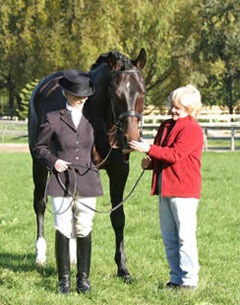
The "horsiest" nations on the southern hemisphere, Australia and New Zealand, were not considered serious dressage countries for a long time. Whereas Australia was able to send individual riders to World Championships and Olympic Games from the beginning of the 1980s, New Zealand had to wait much longer to appear on the international dressage stage.
One woman paved the way for her country by producing the first international caliber dressage horses from New Zealand, representing NZ abroad and raising a daughter, who is nowadays considered the country's greatest talent in dressage.
Sharon Field has influenced dressage in NZ as much as her daughter has and both still do by running „Field Equestrian“ in Pahiatua. The story of these two dressage kiwis is one of bringing their favoured discipline from the shadow into the light. Reason enough to get to know them better.
Pioneer days
Sharon Field started riding at the age of 9 and like most in NZ came through the Pony Club system, concentrating on jumping and eventing. Dressage was less popular and almost non existent at higher levels. Being under 16 she was able to earn the „Dorothy Campbell Trophy“ by winning the NZ Pony Club Eventing Championships as well as the NZ Pony of the Year title in jumping in 1965.
NZ's competitive riding in general then was quite in its infancy, let alone dressage, and Sharon stopped riding when she was 16. Fourteen years later she restarted after she had seen a rider on TV performing one time changes, which inspired her to take up dressage, then rather exotic to many New Zealanders.
Qualified trainers were hard to find, but Sharon was lucky to start with Eric Ropiha, who was one of the first in his country to breed quality dressage horses. He sold a grey NZ sport horse mare, Silver Fern, as a 3,5 year ol youngster to Sharon and both very much learned to ropes together.
 The talented mare "who had a wonderful natural extension and an easy ability to collect" became the first of four horses Sharon trained to Grand Prix. Both won their first FEI Grand Prix at Taupo in 1989 and were part of the first NZ dressage team to compete abroad. At the CDA Sydney Silver Fern placed 2nd in the GP and won the Special. The mare was even able to beat Australia’s top combination Glennis Scott and Livius, who had attended in the World Cup final.
The talented mare "who had a wonderful natural extension and an easy ability to collect" became the first of four horses Sharon trained to Grand Prix. Both won their first FEI Grand Prix at Taupo in 1989 and were part of the first NZ dressage team to compete abroad. At the CDA Sydney Silver Fern placed 2nd in the GP and won the Special. The mare was even able to beat Australia’s top combination Glennis Scott and Livius, who had attended in the World Cup final.
"She was my most talented horse to date, but she suffered from my learning dressage on her," admits Sharon.
Even when Silver Fern retired at the beginning 1990s she continued to influence dressage in NZ as the excellent broodmare she proved to be. Giving birth to four foals, the mare produced one that became a Grand Prix horse, another (Concerto) which was an outstanding broodmare and Vettori,the spitting image of his dam and an international three- day- eventer with Olympic champion Stuart Tinney from Australia. NZ's first international dressage winner passed away aged 25 and is buried in the Field's garden.
An Olympic Dressage Horse from New Zealand
Though horses bred in New Zealand had competed successfully in the Olympics in the disciplines of jumping and especially three-day-eventing, no dressage horse from there was able to make the Games until 1996. Sharon's second Grand Prix horse became NZ's first Olympic dressage horse.
 Mosaic, another horse bred by Eric Ropiha and bought by Sharon as a 3,5 years old, was a lovely chestnut of rather diminutive size. He was one of the most successful dressage horses of the „Hanoverian in NZ“, founded in 1977, even though he was never officially branded by a breed society. Mosaic was bred in 1984 by the imported Hanoverian stallion Witzbold (by Winnetou- Lungau II), who became most influential in NZ warmblood breeding, siring Olympic horses for all three disciplines.
Mosaic, another horse bred by Eric Ropiha and bought by Sharon as a 3,5 years old, was a lovely chestnut of rather diminutive size. He was one of the most successful dressage horses of the „Hanoverian in NZ“, founded in 1977, even though he was never officially branded by a breed society. Mosaic was bred in 1984 by the imported Hanoverian stallion Witzbold (by Winnetou- Lungau II), who became most influential in NZ warmblood breeding, siring Olympic horses for all three disciplines.
Sharon trained Mosaic to Grand Prix with the help of her longtime trainer Clemens Dierks and „he won everything he could in New Zealand." Though Sharon qualified him for the 1996 Olympic Games the NZ federation unfortunately decided not to send a representative in dressage to Atlanta. Mosaic, who had been successful at the important Australian CDIs before, was subsequently sold to Mary Hanna from Australia, who made herself a name internationally with this little horse. She showed him very successfully at the 1996 Olympics, reaching the GPS and she went on to compete him in the WEG 1998 in Rome as well as at the World Cup Finals after they had made their international debut at the WEG in 1994.
The first ever dressage horse from New Zealand still lives with his long time rider in Australia and according Mary Hanna, is doing very well.
Like mother like daughter
While Sharon produced the first Olympic dressage horse from New Zealand, her daughter Kallista was the first dressage rider from NZ competing in Olympic Games.
Kallista, born in 1978, took over from her mother writing new chapters in the history of dressage in NZ and thereby bringing the country to new heights in its least favoured discipline. Thanks to her international success the popularity of dressage grew enormously over the past decade.
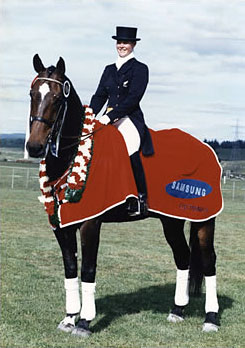 Kallista started riding at age four, "chasing my sister on her pony begging for a ride."
Kallista started riding at age four, "chasing my sister on her pony begging for a ride."
Already two years later she started eventing and soon showed her determination and talent, winning the „Dorothy Campbell Trophy“ like her mother did decades before.
At 14 Kallista's parents forced her to make a choice on which discipline to focus. She obviously made the right one by choosing dressage. Kallista was trained by her mother from the beginning, Eric Ropiha also helped during her Pony Club days. Kallista was given her first horse, Janeiro. A leggy Australian bred horse by the imported BWP stallion Jaguar. Sharon has bought the bay as a 6 years old but she only rode him once before she handed him over to her daughter.
When Kallista got Janeiro and began with dressage seriously she regularly started to train with her mother's longtime trainer Clemens Dierks. A native German living in Australia Clemens had helped the Fields with their horses since 1988. He and his wife Judy, who competed in the 1994 WEG on Dom Perignon, are highly regarded dressage trainers in „Australasia“ and abroad. Clemens was Australian national coach and has helped riders from different countries at WEG and Olympics.
Though Kallista was only a teenager when she was and Janeiro were being coached by Clemens, Dierks' guidance turned the mount into a successful dressage horse. "He was a horse that tried so hard to please me every day," his rider recalled. In 1994 both became the NZ Champions at M-level, before moving to Grand Prix.
Kallista was only 17, an age where teenagers in Europe compete in juniors competitions, when she rode Janeiro in their first Grand Prix. Samsung sponsored a World Challenge tour at different levels in different countries, where dressage was rather in its infancy. Janeiro won this competition in 1996 and again in 1997.
Quite an achievement for such a young rider, who traveled to the mecca of the sport in 1996. Clemens Dierks had arranged for Kallista to go to the late Herbert Rehbein in Germany. For nine months she had an opportunity very few riders could experience: She worked for the Rehbeins at Gröhnwohldhof and was even allowed to have a few rides on their most famous stallions, Don Primero and Donnerhall. However for Kallista the most inspirational thing was „to see Herbert Rehbein ride. He never moved when he rode and every horse he sat on moved like magic.“
 Field came back to NZ and took over a second Grand Prix horse, her mother's. Waikare was bred in 1986 by Brian and Marie Pyke and was bought as a weanling by Sharon. Like Mosaic the dark bay mare was a NZ Hanoverian by Witzbold, but out of a pure thoroughbred mare, Rooklyn xx (by Rocky Mountain xx). Sharon had trained the thoroughbred stamped Waikare to Grand Prix level and had impressed the judges the at 1995 CDI Sydney and the Volvo World Cup League Final in Werribee as well as winning the NZ Championships.
Field came back to NZ and took over a second Grand Prix horse, her mother's. Waikare was bred in 1986 by Brian and Marie Pyke and was bought as a weanling by Sharon. Like Mosaic the dark bay mare was a NZ Hanoverian by Witzbold, but out of a pure thoroughbred mare, Rooklyn xx (by Rocky Mountain xx). Sharon had trained the thoroughbred stamped Waikare to Grand Prix level and had impressed the judges the at 1995 CDI Sydney and the Volvo World Cup League Final in Werribee as well as winning the NZ Championships.
The change of rider had one big goal: representing NZ in Olympic dressage for the first time ever, with the 1998 World Equestrian Games in Rome leading up to that. NZ sent its first dressage team ever to WEG and Kallista, not yet 20, was in the privileged position to qualify both Janeiro and Waikare. In the end Janeiro was chosen because it was clear she couldn't afford to take her horse back down under after the WEG and Waikare was the better horse to keep. "Janeiro traveled brilliantly to Europe," recalls Kallista, who attended the renowned CDI Donaueschingen in south Germany to prepare for the WEG.
Of course none of the NZ ladies' team was able to threaten the top riders in Rome. Cindy Kent was the best, placing 66th of 83 riders on Playskool, another NZ chestnut by Witzbold, full brother to Mosaic. Kallista was the youngest rider in the field and the atmosphere of such a big championships influenced her: "I warmed up next to all these lovely horses and I felt a bit overwhelmed. However I decided to go out there and do our best. Janeiro then performed to his utmost."
Coming 75th may sound not a great result, but one must see that this horse, never really bred for dressage, was trained by Kallista as a teenager, so just taking part in the WEG was an accomplishment. „We were very proud of Janeiro," Sharon disclosed.
Janeiro was sold right after Rome, a pity for the Fields, but a sacrifice many riders had to face in the past when traveling to big championships so far away.
An Olympic dressage rider from New Zealand
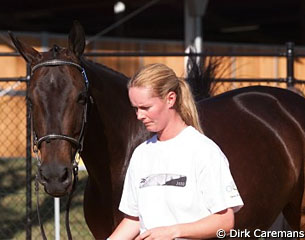 Back in NZ Kallista, Sharon and Clemens Dierks focused on the Sydney Olympics. Waikare qualified easily by winning the GP at the 1999 World Challenge in NZ and had a total triumph in Australia, where she won the GP and the freestyle at CDI Sydney and the GP at CDI Melbourne. Now it was obvious NZ not only had a dignified first ever representative in Olympic dressage, but also quite a competitive one. Kallista's goal for the Olympics was "to get 66% and make the cut for the Special.“
Back in NZ Kallista, Sharon and Clemens Dierks focused on the Sydney Olympics. Waikare qualified easily by winning the GP at the 1999 World Challenge in NZ and had a total triumph in Australia, where she won the GP and the freestyle at CDI Sydney and the GP at CDI Melbourne. Now it was obvious NZ not only had a dignified first ever representative in Olympic dressage, but also quite a competitive one. Kallista's goal for the Olympics was "to get 66% and make the cut for the Special.“
The European experts were most impressed to see this pair, quite unknown to them so far, perform so brilliantly in the Sydney Olympics. "Waikare liked to passage and do extended trot," and she also showed a very nice piaffe. By reaching the Grand Prix Special and finishing in 18th place overall Kallista succeeded in her aim. Moreover she had proved that a very young rider from a country without a long tradition in dressage and on a horse bred in NZ could be competitive and convince the judges that there is quality between A and C from the other side of the globe. "I was happy they liked Waikare," Kallista recalled.
After the Olympics, the 14-year old mare retired to become a broodmare. "Waikare retired at the top of her game. She deserved it and she gave her all to me. Waikare has gone on to be a fabulous broodmare. She's still with us, has just retired from breeding and is the boss of all the mares."
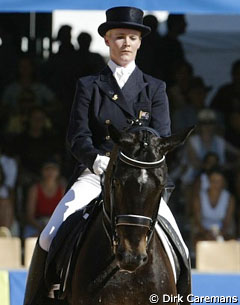 Kallista's promising career wasn't interrupted after Sydney because she has a new horse, Jamahl, at her disposal; again a self- trained horse, which had already won at GP-level in 1999. He continued to win the NZ Championships in 2001, came 3rd in the GP at CDI Melbourne and won the GPS at CDI Sydney before carrying Kallista to her second WEG, in Jerez 2002.
Kallista's promising career wasn't interrupted after Sydney because she has a new horse, Jamahl, at her disposal; again a self- trained horse, which had already won at GP-level in 1999. He continued to win the NZ Championships in 2001, came 3rd in the GP at CDI Melbourne and won the GPS at CDI Sydney before carrying Kallista to her second WEG, in Jerez 2002.
According to Sharon Jamahl was an incredibly sensitive horse and needed to be ridden tactfully, which her daughter did extremely well in the huge stadium in Spain. After Jerez both had the unique opportunity to leave Jamahl in Germany and to bring a very well bred 2 years old Oldenburg stallion, selected at P.S.I., home to New Zealand instead.
Salutation (by Sandro Hit x Welt Hit II) is a horse of a quality „we never believed we would have in our stable“, states Kallista. "He has an outstandingly quiet temperament and though breeding interferes with his training we hope to reach Grand Prix soon.“
Dressage for the Future
Sharon has proved to have a good eye for horses. She mainly looks for movement when scouting young prospects and she is convinced New Zealand has horses to be internationally competitive "if ridden to their potential." One must not necessarily import horses from Europe. Success in the show ring not only inspires other riders, but produces an increasing number of breeders interested in breeding horses for dressage. According to Sharon more breeders in the country now concentrate on breeding dressage horses and the market for them is growing. Of course the breed isn't that far yet that Europeans fly to NZ to look for a dressage horse, like it is common with event horses, but „better horses are competing at our shows now.“
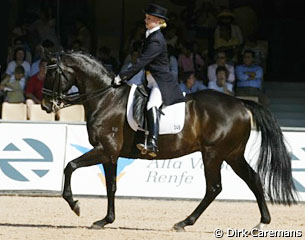
Sharon has established her own breeding program over the past 20 years and was very successful in this, too. Breeding horses for the future, producing and competing them are equally important aims for both Sharon and Kallista. Although Salutation is an imported European horse both believe that the mare is as important as the stallion to breed champions of the future. Though „most important is correct riding and training,“ stressed Kallista, who had shown with a horse like Janeiro how true her claim is.
The future looks promising for Sharon and Kallista to fulfil their ambitions to compete on self-bred horses and improve the standard of dressage in NZ even more. Sharon is currently training Waimoana, a daughter of the famous Hanoverian Weltmeyer out of Waikare and intends to train her to GP. Kallista's hope for the 2012 Olympics in London is Waikiwi, also by Weltmeyer out of Concerto, a quality daughter of Sharon's Silver Fern. This mare are already successful at small tour level. Moreover Kallista is competing Karl Reipen's Oldenburg chestnut Awakino Don Bon Jovi (by Dormello x Anhaltiner), a very talented horse with Olympic potential, which unfortunately sustained an injury, but is hoped to recover.
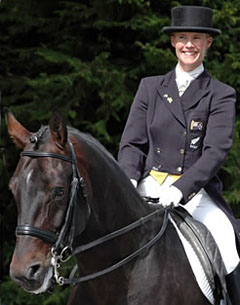 For all their success in training, breeding and competing horses up to the Olympics and the impact this had on the development of dressage Sharon and Kallista Field are "people this country should applaud" to say it with the words of Bill Noble, one of NZ's most regarded dressage trainers.
For all their success in training, breeding and competing horses up to the Olympics and the impact this had on the development of dressage Sharon and Kallista Field are "people this country should applaud" to say it with the words of Bill Noble, one of NZ's most regarded dressage trainers.
"I think success on the world stage inspires everybody. We definitely have more young riders specialising in dressage now," Kallista assessed.
Their secret of success? Total dedication and passion for the same things and the support they give each other day by day. „It's so nice to have come so far together“.
-- by Silke Rottermann
Photos © Private, Barbara Thompson, Dirk Caremans
Related Links
Bill Noble, "Every Man's Story is Important, Unique"
Greatest Oldies: Mosaic, Torch Bearer for Dressage in Australia